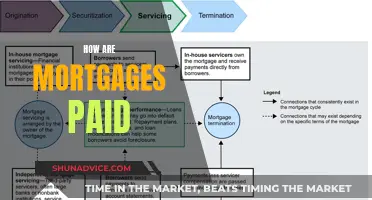
Getting a mortgage can be a daunting process, but it's important to understand the steps involved to make it easier. The mortgage process can be broken down into several steps: pre-approval, house shopping, mortgage application, loan processing, underwriting, and closing. The time it takes to get a mortgage depends on various factors, such as the type of loan, time of year, lender, and mortgage application. If everything goes smoothly, the process can take around one to two months. Before applying for a mortgage, it's essential to assess your finances and ensure you have all the necessary documentation. Lenders will review your credit and income to determine the loan amount you may be approved for. They will also consider the loan-to-value ratio, comparing the loan value to the market value of the property, to assess the lending risk. Once your mortgage application is approved, the closing process begins, where you'll pay the fees, sign the documents, and receive the keys to your new home.
| Characteristics | Values |
|---|---|
| Credit score | The minimum credit score required for a conventional mortgage is 620, while for an FHA loan it is 500. |
| Down payment | The minimum down payment for a conventional mortgage is 3%, while for an FHA loan it is 3.5%. |
| Property type | FHA loans are limited to properties within approved rural and suburban areas. |
| Income | USDA loans require that the borrower's income does not exceed 115% of the average median income in the county where they are buying. |
| Military service | VA loans are only available to former or current service members. |
What You'll Learn

Pre-approval
A pre-approval letter is a statement from a lender that they are tentatively willing to lend money to you, up to a certain amount. It is not a guaranteed loan offer but serves as an indication to sellers that you are likely to be able to get financing. It is a valuable tool when making an offer on a house, especially in a competitive market, as it demonstrates that you are a serious buyer.
The pre-approval amount is based on the information you provide in your application. Lenders will still need to validate all of the information and conduct a final approval before closing. You will also need to get a home appraisal to confirm that the home's value supports the sales price. Most lenders will not provide a mortgage for more than a home is worth.
The credit inquiry involved in applying for pre-approval, known as a "hard pull", may have a small and brief effect on your credit score. However, in some cases, credit inquiries from mortgage applications will not impact your score at all. Pre-approval is an essential part of the journey to getting mortgage financing and can give homebuyers a competitive edge in the market.
Incorporate Closing Costs: Folding Them into Your Mortgage
You may want to see also

Application review
The application review process for mortgage approval can be complex and often stressful, requiring a lot of paperwork. The exact process may vary depending on the lender, but there are some standard steps and requirements that borrowers can generally expect. Here is an overview of the key aspects involved in the application review:
Submission of Documentation:
During the application review, borrowers must provide comprehensive documentation to support their loan application. This typically includes financial records such as tax returns, pay stubs, bank statements, and information about other assets or debts. Lenders use these documents to assess the borrower's financial stability, income consistency, and ability to repay the loan.
Credit Score Evaluation:
The borrower's credit score is a critical factor in the application review. Lenders will pull credit reports from major credit bureaus to evaluate the borrower's creditworthiness. A higher credit score generally indicates lower risk and can lead to more favourable loan terms, including lower interest rates. Minimum credit score requirements vary by lender and loan type, but a good credit score can significantly enhance the chances of mortgage approval.
Debt-to-Income Ratio Analysis:
Lenders will also assess the borrower's debt-to-income ratio, which compares their total monthly debt payments to their monthly gross income. A lower debt-to-income ratio is generally preferable, as it indicates that the borrower has a better balance between debt and income. Lenders use this ratio to gauge the borrower's ability to take on additional debt and make timely mortgage payments.
Down Payment Verification:
The size of the down payment can impact the likelihood of mortgage approval. A larger down payment reduces the loan amount required and demonstrates the borrower's financial commitment. Lenders may have specific requirements for the minimum down payment, which can vary depending on the loan type and the borrower's financial situation. A higher down payment may also help borrowers secure better interest rates and loan terms.
Property Appraisal:
As part of the application review, the lender will typically order a property appraisal to determine the market value of the home. This ensures that the borrower is not requesting a loan amount that exceeds the value of the property. Lenders want to confirm that the property serves as adequate collateral for the mortgage. The appraisal helps protect both the lender and the borrower from taking on excessive financial risk.
Underwriting and Final Decision:
After reviewing the borrower's application, financial situation, and property details, the lender's underwriting team makes the final decision. Underwriters carefully evaluate all aspects of the loan, ensuring it meets the lender's guidelines and requirements. They may request additional information or documentation before rendering a decision. The underwriter's role is crucial in mitigating risk and ensuring that the mortgage aligns with the lender's standards and the borrower's capabilities.
Trulia Mortgage Estimates: How Reliable Are They?
You may want to see also

Loan processing
The loan processing stage is a crucial step in the mortgage approval process. It involves a thorough evaluation of the borrower's financial situation and the property being purchased. Here's a detailed overview of the loan processing stage:
Mortgage Application:
The borrower completes a mortgage application, providing detailed information about their financial situation, including income, employment, assets, debts, and credit history. The lender will also require information about the property, such as the purchase price, type, and intended use (primary residence, investment property, etc.).
Underwriting:
During the underwriting process, the lender evaluates the borrower's loan application and supporting documentation to assess the risk and decide whether to approve the loan. Underwriters review the borrower's income, employment, credit history, and debt-to-income ratio. They also consider the property's value, condition, and title history. This process can take time, and the underwriter may request additional information or documentation from the borrower.
Appraisal:
The lender will order a property appraisal to determine its market value. A licensed appraiser will inspect the property and compare it to similar homes in the area that have recently sold. The appraisal ensures that the property serves as adequate collateral for the loan amount. If the appraisal comes in lower than expected, it may impact the loan amount or terms.
Title Search and Insurance:
A title search is conducted to ensure that the property has a clear title, free of any liens, claims, unpaid taxes, or other issues that could affect ownership. Title insurance is obtained to protect the lender and borrower in case any unforeseen title problems arise. Homeowner's insurance is also required, providing coverage for the property against potential risks such as fire, theft, or natural disasters.
Conditions and Final Approval:
If the underwriting and appraisal processes are satisfactory, the lender may provide conditional approval. This means that the borrower needs to fulfil certain conditions before receiving final approval. These conditions could include providing additional documentation, such as tax forms, pay stubs, or proof of funds. Once all conditions are met, the lender will give final loan approval.
Closing Disclosure and Final Walk-Through:
After final loan approval, the borrower receives a closing disclosure (CD) at least three business days before the closing date. The CD outlines the final costs, including the down payment and closing costs. The borrower then conducts a final walk-through of the property to ensure that any agreed-upon repairs have been completed.
Closing:
At the closing, the borrower signs the necessary paperwork, provides a cheque for the down payment and closing costs, and receives the keys to their new home. This is the final step in the mortgage approval process, marking the transfer of ownership and the start of the borrower's homeownership journey.
Discover Scorecard Mortgage: How Accurate Are These Assessments?
You may want to see also

Underwriting
The underwriting process is a crucial step in the mortgage approval process. It involves a lender verifying details about your financial situation to determine whether to approve your mortgage application. This process can take anywhere from a few days to several weeks, and sometimes even up to 30-45 days. The timeline depends on various factors, including the need for additional information, the lender's workload, and the efficiency of their practices.
During underwriting, a mortgage underwriter—an employee of the mortgage lender—scrutinises your financial profile. They assess your income, assets, debts, credit report, and property details. The underwriter ensures that you can afford the mortgage and that the loan amount aligns with the value of the property. They also consider your credit history, including how well you've managed previous loans and lines of credit.
Before underwriting, a loan processor or mortgage broker gathers credit and financial information for your application. They may request additional documents, such as proof of assets or answers to specific questions. It is essential to respond promptly to these requests to keep the process moving forward.
The underwriter then makes a decision to approve, deny, or pend your application. If approved, you may get a clear to close indication, meaning you can proceed with scheduling the closing. However, approval may come with conditions, requiring you to provide additional documentation or information. If your application is denied, understanding the reason is crucial to deciding on your next steps.
Factors That Determine Mortgage Amounts
You may want to see also

Closing
During the closing process, you will be required to review and sign a variety of documents. These documents will include the final loan agreement, which outlines the terms and conditions of your mortgage, including the interest rate, monthly payments, and any associated fees or penalties. You will also need to provide proof of insurance and verify that the property taxes are current.
In addition to the loan agreement, there may be other documents to sign, such as disclosures and agreements related to the property and the transaction. It is important to carefully review all the documents before signing to ensure that you understand your rights and obligations as a borrower.
To ensure a smooth closing process, it is advisable to work with a reputable lender or mortgage broker who can guide you through the entire procedure. They can help you understand the documents, answer any questions you may have, and ensure that you have all the necessary information and funds required to finalise your mortgage loan.
The Creation Process of Mortgage-Backed Securities Explained
You may want to see also
Frequently asked questions
The first step is to get pre-approved by a mortgage lender. The pre-approval process includes a review of your credit and income to determine how much a lender may lend you.
Pre-qualification is an estimate of how much someone can afford to spend on a home, while pre-approval means the lender has checked the buyer's credit, verified assets, and confirmed employment to approve a specific loan amount.
The next step after pre-approval is house shopping. Once you've found a home you'd like to buy, it's time to apply for the mortgage.
After you submit your mortgage application, the lender will review it and decide whether to pre-approve, deny, or pre-approve with conditions. If your application is approved, the closing process will begin, where you'll pay all fees, sign all documents, and receive the keys to your new home.







